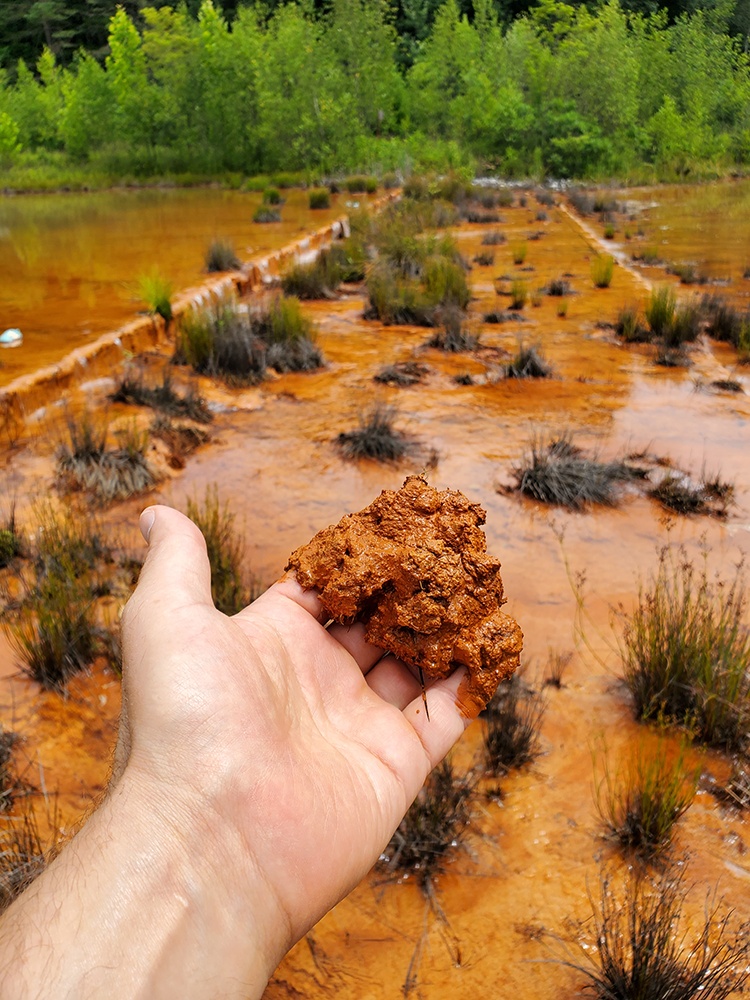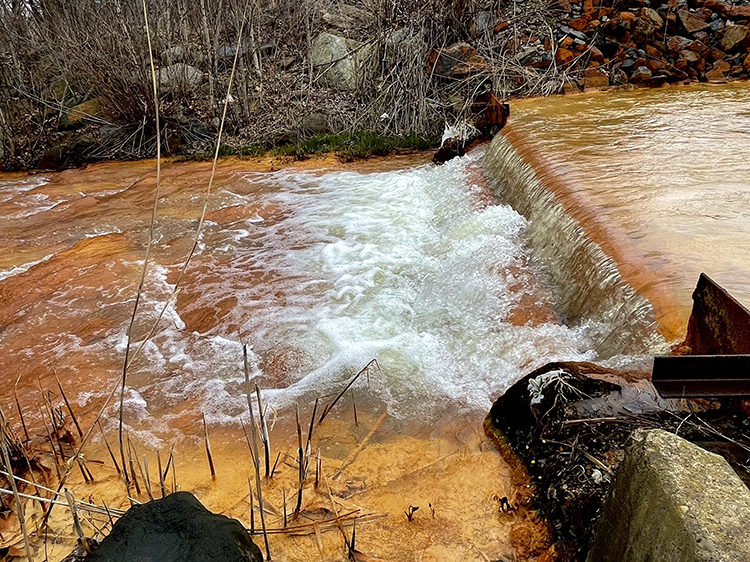Acloudy pool of water marks the spot where, every minute, about 1,200 gallons of toxic mine drainage, contaminated with sulfuric acid and iron, flows out of the ground in the hills above New Philadelphia, in Schuylkill County. Below lies a flooded mine void, the space where miners extracted tons of anthracite coal from the ground to be shipped to (old) Philadelphia using canals along the Schuylkill River or railroads paralleling its course.
To prevent the pollutants from following the same path, in 2010 the Schuylkill Headwaters Association, working with a network of state and local partners, built a series of five wide pools, or “cells,” covering eight acres to treat the water before it enters Silver Creek, a tributary of the Schuylkill. As the water spreads out and flows slowly through the cells, it absorbs oxygen from the air, allowing the iron to settle out as a lurid orange sludge. Two of the cells employ cattails, rushes and other wetland plants to trap more pollutants.

Pennsylvania has thousands of abandoned coal mines, many of them leaking toxic waste into nearby streams. When the Schuylkill Headwaters Association conducted an inventory of abandoned mine drainage sites in the watershed, they counted 164, according to Bill Reichert, president of the all volunteer group. (These sites were commonly referred to as “acid” mine drainage, but since, technically speaking, not all polluted mine drainage is acidic, the conventional term these days is “abandoned mine drainage.”)
The pollution is the legacy of centuries of anthracite coal mining in Northeastern Pennsylvania. The first anthracite coal mine was built near Pittston in Luzerne County in 1775. In the Schuylkill, drainage credit goes to Necho Allen, a hunter who, in 1790, according to local legend, found that some of the rocks near his campfire ignited. In the early 1800s he went into business with a partner mining anthracite (the purest grade of coal, compared to bituminous and lignite) near Pottsville and shipping it to Philadelphia.
Anthracite is a beautiful rock, black and lustrous with a silky texture. It seems to soak up light even as it glitters. More important than its appearance, though, is the fact that it produces plenty of heat from a small package. In the 1800s coal overtook water power as the fuel of choice of the Industrial Revolution. Anthracite was also the primary way that Philadelphians heated their homes for 100 years beginning in the mid-1800s. Canals and then railroads brought anthracite from the upper reaches of the Schuylkill watershed into Philadelphia, where it was burned or shipped elsewhere.
Anthracite production climbed through the 1800s into the 1900s, peaking in 1917 at more than 100 million tons annually. From there it declined, down to about 3 million tons per year today, according to Dan Koury, a watershed manager for the Pennsylvania Department of Environmental Protection, based in Pottsville. From 1870 through 2016 miners took more than 5 billion tons of anthracite out of the mountains, totalling more than 4 billion cubic yards, leaving behind vast underground voids in the mountains of Northeastern Pennsylvania.
“So when they were mining they had to pump water in order to mine,” Koury says. Otherwise groundwater would fill the mines. That pumped water carried silt and other mine waste with it. “So you can imagine what the Schuylkill River looked like in the 1800s,” he says.
When mines were abandoned, the voids filled up, resulting in today’s “mine pools.” The water in the pools reacts with pyrite, an iron sulfide mineral common in Pennsylvania bedrock. This reaction acidifies the water while also adding iron and sulfur compounds. The acidic water dissolves more metals out of the bedrock, yielding a toxic soup. “It just emanates out of wherever the old [mine] entries were, but sometimes it pops out of a subsidence,” Koury says. Once the iron-rich water hits the air, it picks up oxygen and turns its characteristic rusty orange.
The problem is massive. The thousands of abandoned mines pollute waters in 43 of the commonwealth’s 67 counties,and each discharge can cost millions of dollars to treat.
Thanks to environmental laws passed in the second half of the 20th century, mine operators are required to limit pollution from active mines and to guarantee the cleanup of mines that they close. The abandoned mines, for the most part, have no one to clean them up.
The problem is massive. The thousands of abandoned mines pollute waters in 43 of the commonwealth’s 67 counties, and each discharge can cost millions of dollars to treat.
In Pennsylvania, according to Reichert, the Bureau of Abandoned Mine Reclamation focuses its limited resources on mines that pose immediate safety risks, such as open shafts that people could fall into or places where the ground collapses over old voids. This leaves mines that are strictly water pollution sources to groups such as the Schuylkill Headwaters Association.
Founded in 1998, the all volunteer group works to restore the Schuylkill’s watershed in its namesake county. “That means we do a lot of work on abandoned mine drainage discharges. That has been most of the focus of our work from the early days on,” Reichert says. At the headwaters of the Schuylkill they built treatment projects for three discharges that accounted for most of the river’s flow. “So within three miles you have three discharges that make up three quarters of the flow at that point. So if you correct those three discharges that’s 5,000 gallons a minute.”
After taking stock of the abandoned mine drainage (AMD) sources in the Schuylkill’s tributaries, the group began coordinating cleanups, targeting the largest sources of toxic discharge. Most AMD treatment consists of systems to increase the pH of the water (making it less acidic) and allow metals to settle out of the water. In some cases, as in Silver Creek, this means slowing the water enough to let natural processes reduce the pollution. At other sites they direct the water over limestone, which, as it dissolves, makes the water less acidic and allows metals to settle out.
For Silver Creek, the group procured a grant from the EPA for $858,402 to fund the treatment site. The group has built six others, and Reichert says that a few more sites have been removed from the original list as mining resumed, making their discharge the responsibility of the mine operators.
Today the water from the Kaska Silt Dam paints the rocks orange where it enters the main stem of the Schuylkill in Middleport, a couple river miles upstream from New Philadelphia. Here the toxic discharge runs down a moonscape valley otherwise filled in with clay, coal silt and slate rubble, all rinsed from the coal taken out of the adjacent mountain over the course of 150 years of mining. The association will need to excavate 650,000 cubic yards (the volume of about 200 Olympic swimming pools) of the mine waste in order to construct a treatment site.

The price tag will be at least $10 to $12 million, but Reichert is hopeful that recently announced funding from the Infrastructure Investment and Jobs Act will foot the bill.
Abandoned mine drainage is a problem with no permanent fix. As long as the mountains stand, the mine voids will remain, and water will keep flowing from them.
The Schuylkill is getting cleaner, but Reichert expressed some concern that support for the work to restore the Schuylkill could wane as people view the Schuylkill as restored, rather than as a work in progress. After the Kaska site there is a long list of discharges to treat, and the existing treatment facilities need to be maintained and monitored. Abandoned mine drainage is a problem with no permanent fix. As long as the mountains stand, the mine voids will remain, and water will keep flowing from them.
Nonetheless, he still celebrates the victories. Downstream of the Silver Creek site, where its treated water meets the Schuylkill River (which, at this early point in its course, is about 10 feet wide), the water is now clean enough to stock trout. “In the town of New Philadelphia,” Reichert says, “I never ever expected in my life to have a trout stream in my town.”










I wrote extensively on coal silt as a graduate student in 2013. Would love to share my thesis. I dated the earliest arrival of the coal silt capping two mid-channel islands in the Susquehanna River. I dated the coal silt based on non-coal enriched layers beneath the silt that contained historic diagnostic ceramics. Please take a look. You will find it very interesting. https://www.academia.edu/11149229/The_Black_River_Deposits_of_Coal_Silt_Along_the_Susquehanna_River_Pennsylvania.